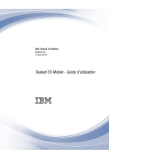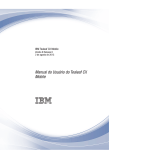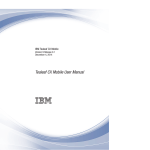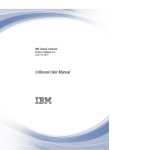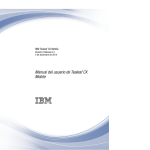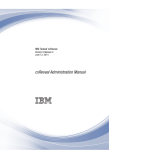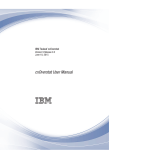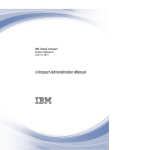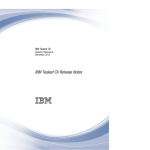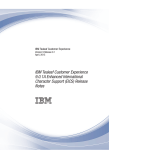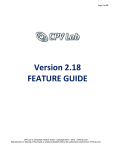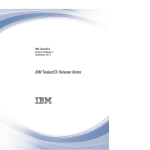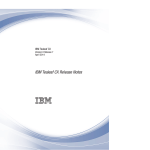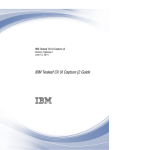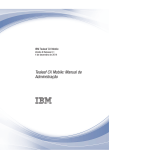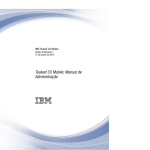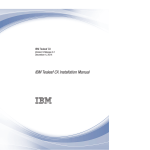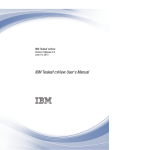Download IBM Tealeaf CX Mobile: Tealeaf CX Mobile User Manual
Transcript
IBM Tealeaf CX Mobile
Version 9 Release 0
June 12, 2014
Tealeaf CX Mobile User Manual
Note
Before using this information and the product it supports, read the information in “Notices” on page 47.
This edition applies to version 9, release 0, modification 0 of IBM Tealeaf CX Mobile and to all subsequent releases
and modifications until otherwise indicated in new editions.
© Copyright IBM Corporation 1999, 2014.
US Government Users Restricted Rights – Use, duplication or disclosure restricted by GSA ADP Schedule Contract
with IBM Corp.
Contents
Tealeaf CX Mobile User Manual. . . . . v
Chapter 1. Overview of CX Mobile . . . 1
Differences in the Mobile Experience . . . . . .
Benefits . . . . . . . . . . . . . . . .
Key Features of Tealeaf CX Mobile . . . . . . .
Available Mobile Data by License . . . . . .
Getting Started with Tealeaf CX Mobile . . . . .
Enabling CX Mobile . . . . . . . . . . . .
Acquire License Key . . . . . . . . . . .
Acquire Latest BrowsCap.csv . . . . . . . .
Acquire Latest WURFL. . . . . . . . . . .
Convert the latest WURFL data to Tealeaf format
Import the Mobile Dashboards . . . . . . .
Update the Event Values Lists with the latest User
Agent data . . . . . . . . . . . . . .
Instrumenting CX Mobile for Mobile App . . . .
1
2
2
3
7
7
7
8
8
8
8
8
8
Chapter 2. Search and Replay for
Mobile Web . . . . . . . . . . . . . 11
Identifying Mobile Web Sessions from Mobile
Devices . . . . . . . . . . . . . . .
Search . . . . . . . . . . . . . . .
Portal Search . . . . . . . . . . . .
Replay . . . . . . . . . . . . . . .
Mobile Replay overview . . . . . . . .
Limitations in Replay of Mobile Visitors . . .
BBR configuration . . . . . . . . . .
BBR replay screen . . . . . . . . . .
Screen Dimensions for Mobile Devices . . .
User interface events from mobile browsers in
BBR . . . . . . . . . . . . . . .
Troubleshooting . . . . . . . . . . . .
Traffic Type is not populated . . . . . .
UI Events not displayed in replay . . . . .
.
.
.
.
.
.
.
.
.
11
12
12
14
14
14
15
16
19
.
.
.
.
19
19
19
20
Chapter 3. Search and Replay for
Mobile Apps . . . . . . . . . . . . 21
Before You Begin . . . . . . . .
Identifying Mobile App Sessions . . .
Mobile-Related Event Objects Provided
Tealeaf . . . . . . . . . . .
Search . . . . . . . . . . . .
Portal Search . . . . . . . . .
© Copyright IBM Corp. 1999, 2014
.
.
by
.
.
.
.
.
.
.
. 21
. 21
.
.
.
.
.
.
. 22
. 23
. 23
Replay of Mobile App Sessions through HTML
representation . . . . . . . . . . .
Limitations . . . . . . . . . . .
Replay of Mobile App Sessions through Screen
Captures . . . . . . . . . . . . .
Limitations . . . . . . . . . . .
Browser-specific features in BBR replay . .
Screen Dimensions for Mobile Devices . .
Browser Based Replay Session Replay . .
.
.
. 26
. 27
.
.
.
.
.
.
.
.
.
.
Chapter 4. Events for Mobile Visitors
Enabling Extended User Agent Detection .
Acquiring Tealeaf CX Mobile Events through
Mobile Dashboard . . . . . . . . .
How Mobile Visitors Are Detected. . . .
Information inserted into the request . .
Mobile Events . . . . . . . . . .
Browser Traffic Type Event . . . . .
Creating Other Mobile Events . . . .
Dimension Value Lists . . . . . . .
Reporting on Mobile Events . . . . . .
33
. . .
the CX
. . .
. . .
. . .
. . .
. . .
. . .
. . .
. . .
Chapter 5. Reporting for Mobile Web
Tealeaf CX Mobile Dashboard .
Building Your Own Reports . .
.
.
.
.
.
.
.
.
.
.
28
28
28
29
30
33
33
33
33
35
35
36
37
37
39
.
.
. 39
. 39
Chapter 6. Reporting for Mobile App . . 41
Pre-requisites . . . . . . . .
Two data transmission methods
Configuring Event Objects . . .
Investigating the Data . . . . .
Creating Reports . . . . .
Tracking Variations . . . . .
Search . . . . . . . . .
Available Dashboards . . . .
.
.
.
.
.
.
.
.
.
.
.
.
.
.
.
.
.
.
.
.
.
.
.
.
.
.
.
.
.
.
.
.
.
.
.
.
.
.
.
.
.
.
.
.
.
.
.
.
41
41
42
42
42
42
43
43
Chapter 7. IBM Tealeaf documentation
and help . . . . . . . . . . . . . . 45
Notices . . . . . . . . . . . . . . 47
Trademarks . . . . . . .
Privacy Policy Considerations .
.
.
.
.
.
.
.
.
.
.
.
.
. 49
. 49
iii
iv
IBM Tealeaf CX Mobile: Tealeaf CX Mobile User Manual
Tealeaf CX Mobile User Manual
This manual details the IBM Tealeaf CX Mobile module for the IBM Tealeaf CX
platform, which enables analysis and reporting on visitors who use mobile devices
to access your web applications through mobile web browsers and mobile apps.
© Copyright IBM Corp. 1999, 2014
v
vi
IBM Tealeaf CX Mobile: Tealeaf CX Mobile User Manual
Chapter 1. Overview of CX Mobile
The IBM Tealeaf CX Mobile modules capture, replay, and analyze the experiences
of visitors those are accessing your web application by using web browsers or
mobile native applications on mobile devices. As the installation base of mobile
devices continues to expand, gaining insight into this rapidly developing market is
critical to making more informed decisions about optimizing your website for the
mobile experience.
Note: The IBM Tealeaf CX Mobile module is a separately licensed module of the
IBM Tealeaf CX platform. please contact your IBM Tealeaf representative.
v For more information about enabling, see “Enabling CX Mobile” on page 7.
v For more information about data that is acquired from mobile devices, see
“Available Mobile Data by License” on page 3.
For customers who are deploying mobile native applications, the IBM Tealeaf CX
Mobile for Mobile App components capture user interface events and application
events and properties from the mobile native applications you deployed for your
customers. Developers can integrate the supported Logging Frameworks with the
deployed application and enable the capture of this rich set of application data for
use in Tealeaf.
v See “Instrumenting CX Mobile for Mobile App” on page 8.
Given the wide array of mobile devices in use on the web, forward-thinking
enterprises must be able to examine how to best serve this diverse and growing
customer segment. Through IBM Tealeaf CX Mobile, you can monitor the mobile
user experience with the same Tealeaf suite of analysis tools that are used for
visitors on desktop systems. Additionally, Tealeaf's event-driven capabilities
segment mobile users for detailed reporting to meet your enterprise requirements.
Differences in the Mobile Experience
The value of the mobile customer experience to the present and future of
eCommerce cannot be overstated. Yet, that experience is fundamentally different
from the user experience and expectations of the desktop browser. Mobile users:
v are task-oriented
v want efficient and quick resolution of their transactions
v get easily frustrated
v have a more personal point of view with online interactions
These characteristics suggest that management of the mobile customer's experience
fits well into the kinds of activities that can be monitored through Tealeaf. Tealeaf's
innovative methods for monitoring customer struggle provide unique insight into
areas where your mobile customers are getting frustrated and potentially
abandoning transactions. By deploying IBM Tealeaf CX Mobile, you can monitor
mobile customer experience and processes with a fidelity not available in other
solutions.
© Copyright IBM Corp. 1999, 2014
1
Benefits
IBM Tealeaf CX Mobile delivers these key benefits on the mobile user experience,
which can be unavailable through other solutions:
v Visibility into mobile user success and failure:
– Detect obstacles or issues without relying on user feedback
– Understand usage by mobile devices across the user base, site, and apps
– Identify cause without having to update or relaunch services
– Visibility into usage patterns across the entire user base
v Accelerate time-to-market:
– Stop waiting on user feedback before you make improvements
– Rapidly evaluate mobile features: adoption, success, and failure points
– Eliminate poor quality to deliver winning mobile services
v Make the right mobile investments:
– Quantify® business impact to prioritize decisions: fix, invest, and remove
– See the actual usage of mobile services rather than the expected usage
In addition to standard analytics capabilities in capturing user profiles and
reporting on time-based activities, the Tealeaf mobile solution provides insight into
why activities are happening through the following capabilities:
v Detection of user struggle
v Ability to drill down into visitor behavior to analyze individual sessions
v Ability to correlate visitor behavior with network data
Key Features of Tealeaf CX Mobile
v Capture of Web and Application Events: IBM Tealeaf CX Mobile enables the
monitoring and capture of client-side interactions through mobile web browsers
and native applications. These events are captured transparently to the user and
submitted to Tealeaf for capture and processing through your installed Tealeaf
solution.
– Device demographics can be captured through the user agent string that is
submitted by the device or the installed Tealeaf client framework that is used
to monitor the device
– Capture of exception messages for processing and rapid reporting
v Mobile Session Replay: IBM Tealeaf CX Mobile captures the complete set of
interactions of every mobile visitor. You can replay captured sessions in a
browser-level recording through Browser-Based Replay. Session replay for
mobile devices accounts for browser capabilities, screen sizes, and other
characteristics of the device and its browser.
– Support for mobile-specific actions such as orientation change, swipe, and
more
– Render in replay by using screen dimensions, known device characteristics,
and orientation
– For more information about search and replay for Mobile Web, see Chapter 2,
“Search and Replay for Mobile Web,” on page 11.
– For more information about search and replay for Mobile App, see Chapter 3,
“Search and Replay for Mobile Apps,” on page 21.
– For more information about Browser-Based Replay, see "CX Browser Based
Replay" in the IBM Tealeaf cxImpact User Manual.
2
IBM Tealeaf CX Mobile: Tealeaf CX Mobile User Manual
v Mobile Visitors and Device Metrics: IBM Tealeaf CX Mobile enables detailed
data capture on mobile visitors and their devices. Usage statistics and trending
patterns can be monitored through provided reports. You can also create ad hoc
visitor segments that are based on mobile attributes such as device
manufacturer, operating system, screen resolution, and more.
– For more information about visitor segments, see "Analyzing Visitor
Segments" in the IBM Tealeaf cxResults User Manual.
Available Mobile Data by License
Depending on the products you have Tealeaf license, the following data is
captured for sessions experienced through mobile devices.
Table 1. Available Mobile Data by License
License
Capability
Description
IBM Tealeaf
cxImpact
Capture user agent data
When extended user agent parsing is
enabled, IBM Tealeaf cxImpact can
capture data that is submitted with
each request by the visitor's user
agent. This data is inserted into the
request by the Tealeaf Reference
session agent, which uses a deployed
version of the browscap public
standard to look up more data. Part
of this data insertion is identifying
whether the session was initiated
from a mobile device or not.
Note: If you do not deployIBM
Tealeaf CX UI Capture j2, some
aspects of the mobile visitor
experience cannot be replayed. For
best results in displaying orientation
change, enabling resizing of the
replay view screen, you must deploy
UI Capture. See the IBM Tealeaf UI
Capture for j2 Guide.
v Extended user agent parsing is
enabled by default. See "Tealeaf
Reference Session Agent" in the
IBM Tealeaf CX Configuration
Manual.
v For more information about user
agents, see "Managing User
Agents" in the IBM Tealeaf cxImpact
Administration Manual.
Chapter 1. Overview of CX Mobile
3
Table 1. Available Mobile Data by License (continued)
License
Capability
IBM Tealeaf Capture mobile device properties and
UI events (gesture, touch, and so on)
CX license
(IBM Tealeaf
CX UI
Capture for
AJAX)
Note: IBM
Tealeaf CX
UI Capture
for AJAX is
only
available to
legacy
users.
Description
When the IBM Tealeaf CX license is
enabled, customers can deploy the
IBM Tealeaf CX UI Capture for AJAX
solution. This Javascript-based
solution is deployed from your web
servers to the visitor's browser. It
captures mobile-specific events, such
as gesture and touch events, as well
as mobile device properties.
Note: This license is not enforced in
the product and operates
independently of the other licenses. It
is managed through limited
distribution of the library.
v For more information about IBM
Tealeaf CX UI Capture for AJAX,
see "UI Capture FAQ" in the IBM
Tealeaf UI Capture for Ajax FAQ.
v For more information about
mobile-specific features of IBM
Tealeaf CX UI Capture for AJAX,
see "UI Capture for Ajax Reference"
in the IBM Tealeaf UI Capture for
Ajax Guide.
IBM Tealeaf Capture mobile device properties and
UI events (gesture, touch, and so on)
CX license
(IBM Tealeaf
CX UI
Capture for
AJAX)
When the IBM Tealeaf CX license is
enabled, customers can deploy the
IBM Tealeaf CX UI Capture for AJAX
solution. This Javascript-based
solution is deployed from your web
servers to the visitor's browser. It
captures mobile-specific events, such
as gesture and touch events, as well
as mobile device properties.
Note: This license is not enforced in
the product and operates
independently of the other licenses. It
is managed through limited
distribution of the library.
v For more information about IBM
Tealeaf CX UI Capture for AJAX,
see "UI Capture FAQ" in the IBM
Tealeaf UI Capture for Ajax FAQ.
v For more information about
mobile-specific features of IBM
Tealeaf CX UI Capture for AJAX,
see "UI Capture for Ajax Reference"
in the IBM Tealeaf UI Capture for
Ajax Guide.
4
IBM Tealeaf CX Mobile: Tealeaf CX Mobile User Manual
Table 1. Available Mobile Data by License (continued)
License
Capability
IBM Tealeaf Capture mobile device properties and
CX license
UI events (gesture, touch, and so on)
(IBM Tealeaf
CX UI
Capture j2)
Description
When the IBM Tealeaf CX license is
enabled, customers can deploy the
IBM Tealeaf CX UI Capture j2
solution. This Javascript-based
solution is deployed from your web
servers to the visitor's browser. It
captures mobile-specific events, such
as gesture and touch events, as well
as mobile device properties.
Note: This license is not enforced in
the product and operates
independently of the other licenses. It
is managed through limited
distribution of the library.
v For more information about IBM
Tealeaf CX UI Capture j2, see the
IBM Tealeaf UI Capture for j2 Guide.
IBM Tealeaf
CX Mobile
module
Capture mobile user agent data
When the IBM Tealeaf CX Mobile
module is licensed, the Tealeaf
Reference session agent can perform
more mobile-specific lookups for user
agent information by using the
WURFL public standard. This
standard contains detailed data on
known mobile devices, which are
based upon the user agent string that
is submitted in the request.
v IBM Tealeaf CX Mobile requires
the XML version of the WURFL
standard to be converted to an
internally usable CSV format. If the
IBM Tealeaf CX Mobile module is
not licensed, access to the utility
provided by Tealeaf to perform this
conversion is forbidden. For more
information about WURFL and this
utility, see "Overview of User
Agents for CX Mobile" in the IBM
Tealeaf CX Mobile Administration
Manual.
Chapter 1. Overview of CX Mobile
5
Table 1. Available Mobile Data by License (continued)
License
Capability
Description
IBM Tealeaf
CX Mobile
module
Replay of mobile user agent data,
device properties, and UI events
When IBM Tealeaf CX Mobile is
licensed, the replay of mobile-sourced
sessions is supported in
Browser-Based Replay (BBR).
Note: When IBM Tealeaf CX Mobile
module is not licensed, the following
limitations are applied to replay of
mobile-based sessions:
1. No display of mobile-specific
events, such as scroll and touch
2. No display of mobile device data
during replay
3. No use of a mobile skin
(Extended user agent parsing is
also required.)
4. No display of device orientation
changes
5. No resizing of the screen to the
mobile browser dimensions
The underlying data is captured
independent of the license; enabling
the license allows mobile-based
replay of sessions that are already
captured.
v BBR is a Portal-based method of
replaying sessions. For more
information about BBR replay, see
"CX Browser Based Replay" in the
IBM Tealeaf cxImpact User Manual.
IBM Tealeaf
CX Mobile
for Mobile
App
Capture of native app events for iOS
and Android systems
When IBM Tealeaf CX Mobile is
licensed, customers can request access
to the iOS and Android Logging
Frameworks. When these frameworks
are deployed as part of the native
applications that you build and
deploy to your visitors by using iOS
and Android devices, a large set of
device properties and application
events are captured and submitted to
Tealeaf for processing, enabling close
monitoring of device-specific
activities.
Note: This license is not enforced in
the product and operates
independently of the other licenses. It
is managed through limited
distribution of the library.
v See the IBM Tealeaf iOS Logging
Framework Guide.
v See the IBM Tealeaf Android Logging
Framework Guide.
6
IBM Tealeaf CX Mobile: Tealeaf CX Mobile User Manual
For more information about applying updated license keys to your Tealeaf
solution, see "Managing Your Tealeaf License Key" in the IBM Tealeaf cxImpact
Administration Manual.
Getting Started with Tealeaf CX Mobile
IBM Tealeaf CX Mobile is pre-configured to analyze on sessions that are captured
from visitors by using mobile devices. To meet the requirements of your enterprise,
you must review the following configuration items and reports.
1. Reference data: Tealeaf can identify mobile devices that are based on the device
type or browser type. Additionally, Tealeaf can monitor specific features of the
device, such as video streaming, picture display, and JavaScript capabilities.
v If your UI Capture is licensed and deployed to track user interface events,
events specific to mobile device browsers can be captured and processed by
Tealeaf.
2.
3.
4.
5.
v See "Configuring Tealeaf for Mobile Visitors" in the IBM Tealeaf CX Mobile
Administration Manual.
WURFL: Tealeaf relies on a publicly available standard for identifying mobile
devices. This standard requires regular updating from the source.
v See "Configuring Tealeaf for Mobile Visitors" in the IBM Tealeaf CX Mobile
Administration Manual.
Creating events: Based on the captured user agent data, you can create events
that can be used to identify mobile visitor activities and device capabilities.
Based on these events, you can create alerts and reports for display in the
Portal.
v See Chapter 4, “Events for Mobile Visitors,” on page 33.
Reports on mobile visitors and devices: As needed, you can download report
templates or create custom reports to surface information about the mobile
visitor experience.
v See Chapter 5, “Reporting for Mobile Web,” on page 39.
Mobile Web Replay: Segments from mobile visitors and devices can be replayed
through Browser-Based Replay in the Tealeaf Portal. Browser-Based Replay can
be configured to replay the visitor session at the appropriate screen size for the
device in use and to indicate user interface events.
v See Chapter 2, “Search and Replay for Mobile Web,” on page 11.
6. Mobile App Replay: Sessions can be replayed as screen captures or as an
HTML representation of the native mobile session with information related to
multiple screens. You can replay mobile app sessions in Browser Based Replay.
v See Chapter 3, “Search and Replay for Mobile Apps,” on page 21.
Enabling CX Mobile
You can learn different options of enabling CX Mobile in this section.
Acquire License Key
IBM Tealeaf CX Mobile is enabled through the license key that you enter in the
Tealeaf Installer at upgrade time. A new license key is required. Contact your IBM
Tealeaf representative.
Chapter 1. Overview of CX Mobile
7
Acquire Latest BrowsCap.csv
BrowsCap is a publicly maintained standard for identifying user agents on the
web. You must download and install the latest version of Browscap.csv into your
Tealeaf solution.
v See "Maintaining the CX System" in the IBM Tealeaf CX Installation Manual.
Acquire Latest WURFL
WURFL is a publicly maintained standard for identifying mobile devices in use on
the web. You must download the latest version of WURFL.csv into your Tealeaf
solution.
v See "Maintaining the CX System" in the IBM Tealeaf CX Installation Manual.
Convert the latest WURFL data to Tealeaf format
After you acquire WURFL, you must convert it to a form that is usable by your
Tealeaf solution. Tealeaf provides an external tool to convert the downloaded file.
Use the WURFL2csv.exe program to convert the WURFL .xml file into the required
format.
v See "User Agent Tools" in the IBM Tealeaf cxImpact Administration Manual.
Import the Mobile Dashboards
You can learn about importing mobile dashboards in this section.
Download
Tealeaf published dashboards for IBM Tealeaf CX Mobile, which contain the event
definitions that are required to capture mobile data for aggregation into dashboard
reports.
Import
Use the Report Manager to bring the mobile event reports and dashboard into the
system.
v See "Importing and Exporting Reports" in the IBM Tealeaf cxView User Manual.
Update the Event Values Lists with the latest User Agent data
Event Value Lists are used to display the different browser types, mobile devices,
and platforms. The UAValueListCreator.exe tool creates these values lists, which
you can them import them.
v See "User Agent Tools" in the IBM Tealeaf cxImpact Administration Manual.
Instrumenting CX Mobile for Mobile App
IBM Tealeaf CX Mobile for Mobile App includes a set of Logging Frameworks,
which are deployed by your developers with mobile native applications served to
your customers. When deployed and enabled, the Tealeaf Logging Frameworks
captures user interface events and application events and properties and submit
them in batches to IBM Tealeaf for capture. The information can be captured as a
single screen capture or as an HTML representation with information related to
multiple screens. In this manner, you can closely monitor a predefined set of
events or customize your own events on the application and how users interact
with it.
8
IBM Tealeaf CX Mobile: Tealeaf CX Mobile User Manual
Data that is submitted to Tealeaf is decoded in the Windows pipeline by using a
specialized session agent and is then available for search and reporting as data
inserted into the request.
IBM Tealeaf provides the following Logging Frameworks.
v See the IBM Tealeaf CX Mobile iOS Logging Framework Guide.
v See the IBM Tealeaf CX Mobile Android Logging Framework Guide.
Chapter 1. Overview of CX Mobile
9
10
IBM Tealeaf CX Mobile: Tealeaf CX Mobile User Manual
Chapter 2. Search and Replay for Mobile Web
Tealeaf sessions that were experienced through a mobile device can be replayed
through Browser-Based Replay in the Portal.
Browser-Based Replay replays the visitor experience with your web application.
Screen size is adjusted to account for the smaller displays. Javascript capabilities
are curtailed to match the capabilities of mobile device browsers. Other
characteristics of the mobile browser are also applied to the replay view in BBR.
v If UI Capture is deployed, orientation changes, scroll events, and other user
interface events are represented in replay. See “User interface events from mobile
browsers in BBR” on page 19.
Through mobile replay, Tealeaf users can identify problem areas in the web
application's presentation to visitors to improve it and resolve disputes.
Identifying Mobile Web Sessions from Mobile Devices
Tealeaf identifies that a session is experienced by using a mobile browser through
user agent information that is submitted in each request by the browser to a web
server.
When a hit is processed through the Canister, the Windows pipeline scans the
request for this user agent information. It is then matched up against a public
standard of known mobile devices.
v See "Tealeaf Reference Session Agent" in the IBM Tealeaf CX Configuration Manual.
This capability is enabled by default for fixed user agents, such as desktop
browsers. For mobile devices, more configuration is required, using a different
standard that is known as WURFL.
v See "Configuring Tealeaf for Mobile Visitors" in the IBM Tealeaf CX Mobile
Administration Manual.
If a match for the user agent is found in the WURFL standard, more information
about the device from WURFL is inserted into the request of each hit, including
the screen resolution and JavaScript capabilities of the mobile browser. This
information is inserted into the [ExtendedUserAgent] section of the request:
[ExtendedUserAgent]
TLT_BROWSER=Openwave Mobile Browser
TLT_BROWSER_VERSION=Openwave Mobile Browser6.2
TLT_BROWSER_PLATFORM=
TLT_TRAFFIC_TYPE=MOBILE
TLT_BROWSER_JAVASCRIPT=false
TLT_BROWSER_COOKIES=true
TLT_BRAND=LG
TLT_MODEL=LG MX510
TLT_SCREEN_HEIGHT=220
TLT_SCREEN_WIDTH=176
TLT_COLOR_DEPTH=65536
TLT_PICTURE_SUPPORT=true
TLT_VIDEO_SUPPORT=false
TLT_STREAMING_SUPPORT=false
© Copyright IBM Corp. 1999, 2014
11
In the example, the TLT_TRAFFIC_TYPE=MOBILE name-value pair indicates that
Tealeaf Reference session agent is successfully matched the TLT_BROWSER against the
WURFL public standard for mobile user agents.
v For more information about how the type of the user agent is identified, see
"Configuring User Agent Events" in the IBM Tealeaf cxImpact Administration
Manual.
Using the previous information, you can perform searches for mobile sessions. To
improve search performance, you must use and create event objects through the
Tealeaf Event Manager to identify mobile visitors.
Tealeaf provides a Traffic Type hit attribute to scan the request for the value of
the TLT_TRAFFIC_TYPE variable name. For example, the value for this hit attribute
for the hit is MOBILE.
The hit attribute is used to populate the dimension Traffic Type, which can be
used as a criterion for an event search term. For example, you can search for
specific events where the Traffic Type dimension value is MOBILE. Searches of this
type return all sessions in which the event occurred when the Traffic Type
dimension indicated that it was a mobile session.
To locate mobile sessions, you must search for an event that occurs in every
session, such as Hit Count, which is also associated with the Traffic Type
dimension. Whenever that event fires, the value of the Traffic Type dimension is
also recorded with the event data in the request.
The combination of event=Hit Count and dimension=Hit Count and
dimension_value=MOBILE is then used to locate sessions that Tealeaf identified as
being sourced from a mobile device.
v For more information about searching for mobile sessions, see “Search.”
Search
The ability to search for mobile sessions requires that extended user agent parsing
is enabled in the Tealeaf Reference session agent that is deployed in your pipeline.
v See "Tealeaf Reference Session Agent" in the IBM Tealeaf CX Configuration Manual.
Portal Search
Search examples:
v “Searching for mobile sessions by Traffic Type”
v “Searching for mobile visitors” on page 13
Searching for mobile sessions by Traffic Type
For example, you can use the following method to search for mobile sessions
where the hit count is more than 1.
1. From the Portal menu, select Search > Completed Sessions.
v You can select Active Sessions or All Sessions. These search options are
available for those types of searches, as well.
v See "Searching Session Data" in the IBM Tealeaf cxImpact User Manual.
2. Select the Completed search template, if it is not selected already.
3. From the Search Scope, select AND - Same Session.
4. In the search pane, click Event Values.
12
IBM Tealeaf CX Mobile: Tealeaf CX Mobile User Manual
Click <Select an event. In the Event Selector, select Hit Count.
Next, select the >= value from the drop-down. Enter the value 2.
In the Search pane, click Events. A second search term is added.
In the Events pane, Click <Select an event. In the Event Selector, select Hit
Count.
9. Click Any Dimension.
10. In the Dimension Selector, select Traffic Type and click Select.
11. The Dimension Value Selector is displayed. Select Mobile.
5.
6.
7.
8.
Note: If you have Tealeaf license and deployed a Tealeaf client framework to
capture session data from mobile native applications, you can search for
sessions of those types by selecting the value Mobile_App from the Dimension
Value Selector. See "Integrating Client Framework Data into Tealeaf" in the
IBM Tealeaf Client Framework Data Integration Guide.
v Click Select.
12. The search screen look like:
Portal Search Configured to Find Mobile Sessions
13. Click Search.
14. Results are displayed in a session list.
v See "Searching Session Data" in the IBM Tealeaf cxImpact User Manual.
Searching for mobile sessions from native applications
See Chapter 3, “Search and Replay for Mobile Apps,” on page 21.
Searching for mobile visitors
You can use the method to search the visitors tracked by IBM Tealeaf cxResults for
mobile sessions.
Note: cxResults is a component of CX platform, a separately licensable component
of the Tealeaf CX platform. For more information, please contact your IBM Tealeaf
representative.
To begin searching by visitors, select Search > Visitors. Specify the search criterion
by using the preceding sets of steps.
v See "Searching for Visitors" in the IBM Tealeaf cxResults User Manual.
Chapter 2. Search and Replay for Mobile Web
13
Replay
Mobile Replay overview
You can replay visitor sessions that were experienced through mobile devices
through Browser-Based Replay through the Tealeaf Portal.
For more information about BBR, see "CX Browser Based Replay" in the IBM
Tealeaf cxImpact User Manual.
A mobile license is required for the mobile skin to show in the Mobile Replay.
IBM Tealeaf receives mobile dimensions from two sources, IBM Tealeaf UI Capture
and WURFL. WURFL is used as a fallback if UI Capture is not installed. If both
sources are missing, there is no data to render the mobile skin. A default
dimension is applied and you will see the skin with no page inside.
Note: IBM Tealeaf UI Capture can provide better dimensions. Therefore, it is
recommended to have UI Capture installed for better replay of mobile sessions.
For BBR, sessions that are delivered for replay are rendered on the Replay Server.
This content is delivered to Tealeaf user's browser and rendered in an iframe inside
of that browser.
Sessions that are requested by a BBR user are passed by the Replay Server to a
renderer that is appropriate for the source of the session. For example, Firefox
sessions are passed to the Gecko renderer, while Chrome/WebKit sessions are
passed to the Chrome renderer.
v The Chrome renderer must be enabled. See "Configuring the Replay Server" in
the IBM Tealeaf CX Configuration Manual.
Note: Browser-specific styling cannot be appropriately applied to sessions that are
delivered to a different type of browser. For example, WebKit-specific styles cannot
be applied to a session that is rendered for and delivered to a Firefox browser.
Limitations in Replay of Mobile Visitors
Replay of mobile visitor sessions works best for web pages that are designed for a
mobile platform. These web pages are designed to fit the smaller screens of mobile
devices and work well within the limitations of the device.
Replay of web pages that are targeted for personal computers can vary widely
from the actual experience. Many cell phones and cell phone networks modify the
web page to best fit the display. Typical modifications include collapsing of frames,
restructuring of tables, and resizing of images.
Because these modifications are specific to the device or network, Tealeaf does not
attempt to emulate these behaviors. As standards improve for presentation of
content that is targeted for personal computer screens delivered to small mobile
screens, Tealeaf will improve this emulation.
Note: Replay of sessions for mobile devices that are captured from web
applications that are designed for mobile browsers is likely to feature improved
performance and visual display. However, if the content is delivered for a
14
IBM Tealeaf CX Mobile: Tealeaf CX Mobile User Manual
mobile-only device, there can be visual discrepancies in the replay, due to
differences in the rendering and display issues of the browser controllers that are
used in BBR.
Note: Depending on the pixel density of the device and the pixel density of the
monitor on which you are viewing the replay, the physical size of the displayed
image cannot match the original image.
v For Android devices, if the width or height is less than 320 pixels, the image is
not scaled.
Note: When IBM Tealeaf CX Mobile module is not licensed, the following
limitations are applied to replay of mobile-based sessions:
v No display of mobile-specific events, such as scroll and touch
v No display of mobile device data during replay
v No use of a mobile skin (Extended user agent parsing is also required.)
v No display of device orientation changes
v No resizing of the screen to the mobile browser dimensions
The underlying data is captured independent of the license; enabling the license
allows mobile-based replay of already captured sessions.See Chapter 1, “Overview
of CX Mobile,” on page 1.
For more information about replay for mobile native applications, see Chapter 3,
“Search and Replay for Mobile Apps,” on page 21.
Limitations for Android
1. Android-based devices can screen capture the main window but cannot capture
pop-up windows.
2. For hybrid applications, screen capture can be captured in a random order, and
some screen capture can be missing due to timing issues.
3. Clicks of the device buttons are not captured by the Android logging
framework.
4. When an Android-based web browser is minimized, the application is slept,
instead of killed. As a result, session identifiers are not renewed when the
application is reawakened, and the same session identifier can be used for what
are two separate visitor sessions. When hits from this visitor's sessions are
gathered into Tealeaf, the session data is mixed under a single session identifier.
v For more information about debugging this issue, see "Tealeaf Android
Logging Framework Installation and Implementation" in the IBM Tealeaf
Android Logging Framework Guide.
BBR configuration
You can configure the BBR by using following steps:
For user groups
Through the Portal Management page, Tealeaf administrators can configure BBR
replay to auto-resize according to the screen of the visitor's device for Tealeaf user
groups.
1. Log in to the Tealeaf Portal as an administrator.
2. In the Portal menu, select Tealeaf > Portal Management.
3. In the left pane, click CX User Administration.
4. Click Groups.
Chapter 2. Search and Replay for Mobile Web
15
5.
6.
7.
8.
Select the group.
Click Browser Replay Profile.
Select the Resize Replay pane to Match Session check box.
Click Save.
For individual users
When a session is selected for replay in BBR, you can resize the display window
that is based on the information provided by the visitor's browser.
1. In BBR, select Options > Options > Resize Replay Pane to Match Session.
Figure 1. BBR options for mobile devices
2. If device window size information is available in the user agent data for the
visitor's browser, then that window size is applied to BBR.
See "Browser Based Replay Interface" in the IBM Tealeaf cxImpact User Manual.
BBR replay screen
You can replay mobile sessions by using the same controls to replay desktop
sessions:
1. In the Sessions List, select the session to replay.
v If you searched by visitor, click the Sessions link next to the appropriate
results in the Visitors List.
16
IBM Tealeaf CX Mobile: Tealeaf CX Mobile User Manual
Figure 2. Searching for Mobile Sessions in BBR
2.
3.
4.
5.
To replay, click the Camera icon (
).
In the Replay Session dialog, click Browser.
BBR is opened to replay the session.
For more information about resizing the window that is based on the visitor's
browser, see “BBR configuration” on page 15.
Figure 3. BBR replay of a mobile device
For more information about Browser-Based Replay, see "CX Browser Based Replay"
in the IBM Tealeaf cxImpact User Manual.
Chapter 2. Search and Replay for Mobile Web
17
v If UI Capture is licensed and deployed, more UI events are displayed during
replay. See “User interface events from mobile browsers in BBR” on page 19.
User agent information in BBR
User agent information is inserted in a title bar above the replay pane.
Note: This information is available only if the IBM Tealeaf CX Mobile module is
licensed and properly configured. See "Configuring Tealeaf for Mobile Visitors" in
the IBM Tealeaf CX Mobile Administration Manual.
In the table below, you can review the content of each field, its source, and how it
can be accessed.
Table 2. User agent information in BBR
Item
Source Request field
Description
Browser
TLT_BROWSER
Visitor browser type
v This value is also available in the
Tealeaf System Hit Attribute
Browser. See "TEM Hit Attributes
Tab" in the IBM Tealeaf Event
Manager Manual.
Browser
Platform
TLT_BROWSER_PLATFORM
The mobile device platform
Browser
Major
Version
TLT_BROWSER_VERSION
The version X.0 of the browser
Traffic
Type
TLT_TRAFFIC_TYPE
The type of traffic, as identified by
extended user agent parsing
v This data is also captured in the
Traffic Type dimension. See "TEM
Dimensions Tab" in the IBM Tealeaf
Event Manager Manual.
Replay
Renderer
The type of renderer that is used by
Replay Server to render the session
v The type of renderer is determined
by the configured renderer types
and the browser from which the
session was originally experienced.
See "Configuring the Replay
Server" in the IBM Tealeaf CX
Configuration Manual.
Rendered at original screen dimensions in BBR
The BBR replay pane is rendered at the screen dimensions reported by the mobile
browser.
Note: If no screen information is reported in the title bar for a session that is
identified as mobile, the screen dimension data was not inserted into the request
by the Windows pipeline session agent. This omission typically occurs when the
mobile browser cannot display JavaScript or that feature is disabled.
Additional configuration is required. See “BBR configuration” on page 15.
18
IBM Tealeaf CX Mobile: Tealeaf CX Mobile User Manual
Screen Dimensions for Mobile Devices
BBR and RTV have multiple mechanisms for evaluating the screen dimensions as
reported from the mobile device.
1. If UI Capture is deployed and is submitted UI events to Tealeaf for capture,
then the screen dimensions that are used in replay are taken UI events that are
captured in first hit of the session in replay from the browser of the mobile
device.
2. If UI Capture is not deployed or if UI events are not reported and captured in
the first hit, then screen dimensions are taken from the WURFL standard for
the device that is used by the visitor.
Note: Since the device and the browser for the device can not report the same
values, it is possible that replay of a session by using the screen dimensions
reported by WURFL can not exactly match the dimensions of the captured
session.
3. If neither of the methods yields values for the screen dimensions, BBR and RTV
set the screen dimensions during replay to the full, normal replay size.
User interface events from mobile browsers in BBR
If UI Capture is deployed, user interface events that are captured from mobile
browsers are displayed in the Viewable Pages List in BBR.
v See the IBM Tealeaf UI Capture for j2 Guide.
Note: Replay of scroll events that are captured by UI Capture is supported for
mobile sessions only in BBR only.
In addition to actions such as clicks, gestures such as pinching and zoom in and
zoom out are displayed in BBR.
When the orientation changes in the session, the mobile skin is displayed along the
new axis in BBR.
Note: Pinch and zoom gestures can be captured on the iOS platform only. They
cannot be captured on the Android platform.
Troubleshooting
This section contains some basic troubleshooting information for replay of mobile
visitor sessions.
Traffic Type is not populated
If you are trying to replay what a mobile session in BBR, you can notice that the
Traffic Type value is set to ????.
In this case, mobile replay cannot be properly configured. Support for mobile
replay requires a separate installation and configuration and is not enabled by
default. You cannot download, install, and convert the public standard WURFL.csv
for use in Tealeaf.
Note: Use of WURFL conversion tools is a component of CX Mobile, a separately
licensable component of the Tealeaf CX platform. For more information, please
contact your IBM Tealeaf representative.
Chapter 2. Search and Replay for Mobile Web
19
v See "Configuring Tealeaf for Mobile Visitors" in the IBM Tealeaf CX Mobile
Administration Manual.
UI Events not displayed in replay
If you are not seeing UI events in a mobile session during replay, check the request
of any hit in the session to see whether the following value is present in the
[ExtendedUserAgent]:
TLT_BROWSER_JAVASCRIPT=false
If the visitor's browser does not support JavaScript or is not configured to enable
JavaScript to run, then the UI Capture JavaScripts required to capture and submit
UI events did not run for the session.
v See "Browser Based Replay Interface" in the IBM Tealeaf cxImpact User Manual.
20
IBM Tealeaf CX Mobile: Tealeaf CX Mobile User Manual
Chapter 3. Search and Replay for Mobile Apps
IBM Tealeaf CX Mobile Android Logging Framework and IBM Tealeaf CX Mobile
iOS Logging Framework can be enabled to capture native mobile app data.
Sessions can be captured and replayed as screen captures for visual review and
analysis of the data.
Sessions can be captured as HTML representations with information related to
multiple screens. Sessions that are rendered through HTML representation of the
native mobile session can only be replayed in Browser Based Replay.
Sessions can also be captured and replayed as screen captures for visual review
and analysis of the data.
For all sessions sourced from mobile native applications, you can search through
the Portal to locate them.
Before You Begin
Before you begin, you must configure the attributes and event objects to capture
important data from your mobile native applications.
v See "Integrating Client Framework Data into Tealeaf" in the IBM Tealeaf Client
Framework Data Integration Guide.
Replaying mobile app sessions through JSON requires configuration of the IBM
Tealeaf Logging Framework.
v CX Mobile Android Logging Framework: See "UPDATE TITLE HERE" in the
IBM Tealeaf CX Mobile Android Logging Framework Guide.
v CX Mobile iOS Logging Framework: See "UPDATE TITLE HERE" in the IBM
Tealeaf CX Mobile iOS Logging Framework Guide.
Identifying Mobile App Sessions
In session data, sessions that are generated from mobile native applications are
identified by the following request variable, which is inserted into the HTTP
header:
HTTP_X_TEALEAF=device (<framework>) Lib/<version>
where
v device = a hardcoded string
v <framework> = iOS or Android
v Lib/ = a hardcoded string
v <version> = the version number of the capturing framework
For JSON-based versions of UI Capture, the header value is UIC in the previously
mentioned format.
v For XML-based versions of UI Capture, the header is the following exactly:
HTTP_X_TEALEAF=ClientEvent
© Copyright IBM Corp. 1999, 2014
21
Mobile-Related Event Objects Provided by Tealeaf
In this section, you can find information about mobile related event objects in
Tealeaf.
Mobile Device Type hit attribute
For all client framework sessions, the header information is detected by the Mobile
Device hit attribute. This hit attribute detects the values between the parentheses,
the <framework> value.
Mobile Device dimension
The values that detected by using the hit attribute are recorded to the Mobile
Device dimension.
v If the Mobile Device Type hit attribute is found, the Mobile Device building
block event is triggered. This event is used only to record the values into this
dimension.
The following values can be recorded:
Dimension Value
Description
iOS
Indicates a session that is captured from an iOS device by the IBM Tealeaf
CX Mobile iOS Logging Framework
Android
Indicates a session that is captured from an Android device by the IBM
Tealeaf CX Mobile Android Logging Framework
null value
Note: For any other session, including sessions that are captured from IBM
Tealeaf CX UI Capture j2, a null value is recorded.
Associated Events
The Mobile Device dimension is pre-configured to be included in the Traffic Type
report group. Since this report group is associated with a number of events that are
provided by Tealeaf, when those events are triggered, values for the Mobile Device
dimension are recorded as soon as the installation or upgrade is completed.
v In the sections below, the Page Count event is used as an example event for
locating sessions by using this dimension. This event occurs once per session at
the end of the session, which provides the means of scanning all sessions for this
dimension value.
Note: Because the Page Count event is evaluated at the end of the session, it
cannot be used as a means of locating mobile native application sessions among
your active sessions; the event not yet fired in active sessions.
– To use the Mobile Device dimension to locate active sessions, you must
associate the dimension or one of its report groups with an event that occurs
on the first hit of the session, every hit, after every hit, or any step-based
trigger.
Note: You can use the Report Builder to identify the events with which a
dimension is associated. See "Tealeaf Report Builder" in the IBM Tealeaf Reporting
Guide.
v You can associate the Traffic Type report group with other dimensions or the
Mobile Device dimension with other report groups to expand access to this
segmenting information.
22
IBM Tealeaf CX Mobile: Tealeaf CX Mobile User Manual
v For more information about associating dimensions and report groups with
events, see "TEM Events Tab" in the IBM Tealeaf Event Manager Manual.
Search
You can use the choices in the following section to locate sessions that are sourced
from mobile native applications.
Portal Search
You can use the steps below to locate the above items through the search facilities
in the Portal.
v For more information about portal search in general, see "Searching Session
Data" in the IBM Tealeaf cxImpact User Manual.
Search by dimension value in the Portal
Using the provided event objects, you can search for completed sessions from
mobile native applications through the Portal.
Note: This example uses an event that is calculated on each session but not until
the end of the session. So, this example cannot be used to find all instances among
active sessions. To locate active sessions, you must select a different event, which
occurs on every hit.
1. Log in to the Portal.
2. From the Portal menu, select Search > Completed Sessions.
3. Specify the template and Search Range as needed.
4. To remove any fields in the search panel, click the X icon in the upper-right
corner.
5. In the left panel, click the Events category.
6. The Events search field is added to the search panel.
v If this field is not available, you must select a different search template. See
"Searching Session Data" in the IBM Tealeaf cxImpact User Manual.
v If no search template contains this field, it must be added to at least one
search template. See "Configuring Search Templates" in the IBM Tealeaf
cxImpact Administration Manual.
7. This field searches for the occurrence of specific events and optionally
dimension values. In this example, the Tealeaf-provided event Page Count is
used, and the Mobile Device dimension is already associated with it.
v For more information about creating events to track mobile native
application data, see "Integrating Client Framework Data into Tealeaf" in the
IBM Tealeaf Client Framework Data Integration Guide.
a. Click <Select an event.
b. In the Event Selector, open the Tealeaf Standard Events label.
c. Select the Page Count event. Click Select.
d. The Page Count event is selected.
e. Click Any Dimension.
f. In the Dimension Selector, select the Mobile Device dimension.
Note: If the Mobile Device dimension is not available, the report group
that contains it (Traffic Type report group) is not associated with the event
that you selected to use.
Chapter 3. Search and Replay for Mobile Apps
23
g. In the Dimension Value Selector, select one of the following values that are
depending on the type of session for which you are looking:
v Android
v IOS
h. Click Select. The dimension value is selected as part of the search term.
8. To search for sessions from one of multiple mobile native application
frameworks:
a. Change the Search Scope value to OR - Any Session.
b. Repeat the steps to add the Page Count event by using the Mobile Device
dimension.
c. For the dimension value, select a different mobile native application type.
9. To search for sessions that are initiated from either iOS or Android devices,
your search page must look like the:
Figure 4. Portal Search - Event + Dimension Value search terms
10. You can modify your search as needed.
Note: Set the Search Range to be as narrow as possible to locate the necessary
sessions.
11. When you are ready to search, click Search.
12. Results are displayed in the default session list. See “Search Results.”
Search Results
After your search results are returned, they are displayed in the default session list
template that is associated with the search template that you used.
24
IBM Tealeaf CX Mobile: Tealeaf CX Mobile User Manual
Figure 5. Portal Search - Search Results
The previous session is configured to display search results for all mobile sessions.
The session list includes columns for the user identifier that is captured by each of
the deployed Logging Frameworks.
v For more information about configuring search templates, see "Configuring
Search Templates" in the IBM Tealeaf cxImpact Administration Manual.
The following commands are available:
Table 3. Search Results.
Command
Replay
Icon
Description
Displays the session in the browser.
See “Replay of Mobile App Sessions
through Screen Captures” on page 28.
Chapter 3. Search and Replay for Mobile Apps
25
Table 3. Search Results (continued).
Command
Icon
Description
Page List
View the page list for the session.
See "Searching Session Data" in the
IBM Tealeaf cxImpact User Manual.
QuickView
Open session QuickView, where you
can review the event and
dimensional data for every event that
was triggered in the session.
See "Searching Session Data" in the
IBM Tealeaf cxImpact User Manual.
Session Info
View session properties. See
"Searching Session Data" in the IBM
Tealeaf cxImpact User Manual.
Send to
Event Tester
Send the selected session to the Event
Tester as sample data. See "Event
Tester" in the IBM Tealeaf Event
Manager Manual.
See "Searching Session Data" in the IBM Tealeaf cxImpact User Manual.
Replay of Mobile App Sessions through HTML representation
Using the HTML representation method to replay mobile app sessions, you can
replay a mobile app session in Browser Based Replay as you would an HTML web
session instead of viewing the mobile app session as a series of screen captures.
There are several advantages to using the HTML representation method to replay
mobile app session over screen captures.
v Ability to mask private information
v Ability to draw user interactions (UI events) onto the HTML pages that are
created from the JSON data
v Smaller data size
This method uses JSON data that is captured by the CX Mobile Logging
Frameworks to create a collection of HTML pages, each with a collection of UI
events within a JSON string. When the Replay Server finds a hit with a JSON
string, the JSON Type 10 messages are converted into HTML through a template
engine to render the collection of HTML pages that represent the mobile app
screens. JSON Type 4 messages that follow a Type 10 message are filtered to
produce associated UI Events that are visible in the Navigation List. This provides
you with a deeper insight into your mobile app sessions.
The templates that are used by the template engine can be customized to meet
your business needs. To configure your templates, contact IBM Tealeaf Professional
Services or see "Native app session replay customization in the IBM Tealeaf CX
Configuration Manual.
When you replay a mobile app session and use a Tealeaf Target page (the page
where the mobile device POSTs JSON data) that does not match the naming
convention of TealeafTarget.*, you may see native UI events that are associated
to your unconventional Tealeaf Target pages when they belong to an earlier page.
26
IBM Tealeaf CX Mobile: Tealeaf CX Mobile User Manual
In this case, to avoid this errant association, you can create an Ignore URL replay
rule to filter your unconventional Tealeaf Target pages out of the Navigation List.
Replaying mobile app sessions through HTML representation requires
configuration of the IBM Tealeaf Logging Framework.
v CX Mobile Android Logging Framework: See "Log Screen Layout for Android
Mobile App Replay" in the IBM Tealeaf CX Mobile Android Logging Framework
Guide.
v CX Mobile iOS Logging Framework: See "Log Screen Layout for iOS Mobile App
Replay" in the IBM Tealeaf CX Mobile iOS Logging Framework Guide.
Note: If you replay a mobile app session with no CX UI Capture j2 data, the
mobile skin might be large. The large mobile skin is because IBM Tealeaf did not
receive any data from CX UI Capture j2. When there is no CX UI Capture j2 data,
User Agent data is the fallback. The User Agent data might not be a correct or
normalized properly.
Limitations
When replaying HTML representations of sessions that are generated from
Android apps, there are often empty target pages in the Navigation List. During
rendering, the target pages are converted to ScreenViews and UI Events. However,
the original target pages remain in the Navigation List and appear as empty
pages.
You can use the Ignore URLs rule to remove any of these original pages from the
Navigation List that are not required.
Chapter 3. Search and Replay for Mobile Apps
27
To remove these original pages from the Navigation List, right-click the
target.php page in the Navigation list, and click Remove this page from Replay.
The Ignore URLs rule does not work on sessions that are generated from iOS apps.
Replay of Mobile App Sessions through Screen Captures
You can replay sessions with mobile app screen captures in Browser Based Replay..
Screen capture requires configuration of the IBM Tealeaf Logging Framework.
v Android Logging Framework: See the IBM Tealeaf Android Logging Framework
Guide.
v iOS Logging Framework: See the IBM Tealeaf iOS Logging Framework Guide.
v “Browser Based Replay Session Replay” on page 30
Limitations
As the visitor steps through different views of the native application, a screen
capture can be captured and submitted to Tealeaf for display. During display of
mobile native apps, static screen captures of each view are displayed.
v Screens are captured as soon as the view is initialized and before data is
populated in any fields. It limits the exposure of sensitive data to Tealeaf.
Note: For Android-based sessions, images that are captured from the web server
are stored at the beginning of the session. Images that are captured from the
local instance of the native application are stored in the appropriate locations
throughout the session.
Note: Mobile native application sessions are not replayed by using the mobile
skin.
Note: There is a known issue in which the PCA fails to properly recognize
UTF-8 encoding in data that is submitted from client frameworks. The data can
be mangled in the stored session, causing issues in eventing and search.
Note: The following information applies to IBM Tealeaf version 9.0A only.
9.0A can properly recognize UTF-8 encoding in data that is submitted from
client frameworks.
User agent information
Note: If your client framework is not configured to report a user agent string in
the HTTP_USER_AGENT request header, the extended user agent parsing information
that can be displayed in BBR is reported as unknown in the toolbar at the top of
replay view. The user agent string must match a user string in the public standards
that was deployed into your Tealeaf solution.
v Capture of user agent information requires more configuration. For more
information about user agent detection, see "Managing User Agents" in the IBM
Tealeaf cxImpact Administration Manual.
Browser-specific features in BBR replay
Note: To render sessions captured from mobile devices for display in the web
browser, the Tealeaf Replay Server utilizes an embedded renderer that is based on
28
IBM Tealeaf CX Mobile: Tealeaf CX Mobile User Manual
the Chromium engine. For best results in replay of mobile-based sessions, Tealeaf
recommends using the Chrome browser in Browser-Based Replay.
Sessions that are requested by a BBR user are passed by the Replay Server to a
renderer that is appropriate for the source of the session. For example, Firefox
sessions are passed to the Gecko renderer, while Chrome/WebKit sessions are
passed to the Chrome renderer.
v The Chrome renderer must be enabled. See "Configuring the Replay Server" in
the IBM Tealeaf CX Configuration Manual.
Note: Browser-specific styling cannot be appropriately applied to sessions that are
delivered to a different type of browser. For example, WebKit-specific styles cannot
be applied to a session that is rendered for and delivered to a Firefox browser.
Screen Dimensions for Mobile Devices
If the IBM Tealeaf CX Mobile license and extended user agent parsing is enabled,
captured images are displayed in the screen dimensions that are used on the
mobile device. This is the same device from which the native application session
was captured.
Note: For mobile native application sessions, display of images is determined by
the Logging Framework, which always screen capture the currently configured
resolution for the device. The dimensions cannot be configured in BBR for mobile
native application sessions.
v For the Android logging framework, the screen capture's dimensions are
represented in the left navigation bar, and the image is resized in BBR. If the
Android device has a width or height less than 320 pixels, the image is not
scaled.
v For more information about extended user agent parsing, see "Managing User
Agents" in the IBM Tealeaf cxImpact Administration Manual.
Chapter 3. Search and Replay for Mobile Apps
29
Browser Based Replay Session Replay
Figure 6. Mobile Native Application - BBR Session Replay
In BBR, you can review screen images by selecting the appropriate items in the
Navigation List. These entries signify that a new view is loaded but not populated
with data yet.
v In the Navigable Pages List, mobile native application views and user interface
changes are not numbered.
Note: If your mobile native application enables web-based interactions with a
web server that is monitored by Tealeaf, these web interactions are transmitted
as soon as they occur. Since mobile native application interactions are batched
and submitted periodically, they are timestamped by the PCA after web
interactions, which are submitted in real time. During replay, the web
interactions can be listed and displayed before the mobile native application
interactions that occurred beforehand. This issue is addressed in a later build.
Depending on how data is captured by the Logging Framework and client
application, user data can be available in the Navigable List entries between the
screen capture entries.
For more information on Browser Based Replay, see "CX Browser Based Replay" in
the IBM Tealeaf cxImpact User Manual.
30
IBM Tealeaf CX Mobile: Tealeaf CX Mobile User Manual
Browser Based Replay configuration
For best results in displaying sessions through Browser-Based Replay, IBM Tealeaf
recommends the following configuration settings in Browser Based Replay:
v Options not referenced here can be specified based on your Tealeaf environment.
Table 4. BBR configuration
Setting
Value
Notes®
View > User Agent Info
Do not select.
By default, user agent information is not
populated for mobile native applications. See
"Tealeaf Reference Session Agent" in the IBM
Tealeaf CX Configuration Manual.
Options > Page
Numbering > Use Hit
Numbers
Select.
When the list of pages is displayed by hit
number, then items are numbered in the
following format:
<Letter><Index>
where:
v <Letter> corresponds to an alphabetical
letter, each of which identifies a different
session fragment.
v <Index> corresponds to the index of views
within an ScreenView.
Options > Page Naming
> Use Page Title
Select.
When selected, you can easily see which pages
are marked as Tealeaf Target. Some of these
pages identify the screen captures to review.
v When deselected, pages are displayed by
URL, which may require you to widen or
scroll the Navigable Page List to review.
Options > Advanced >
Merge Session
Fragments
Do not select.
Since mobile native applications are
sessionized in a different manner, this option
does not work for mobile native application
display.
Options > Advanced >
Report Javascript Errors
Do not select.
Does not apply.
Options > Resize View
to Match Session
Do not select.
Replay pane is auto-resized to the size of the
screen capture provided by the Logging
Framework. This setting requires user agent
information to apply. See “User agent
information” on page 28.
See "CX Browser Based Replay" in the IBM Tealeaf cxImpact User Manual.
See "BBR Options" in the IBM Tealeaf cxImpact User Manual.
Chapter 3. Search and Replay for Mobile Apps
31
32
IBM Tealeaf CX Mobile: Tealeaf CX Mobile User Manual
Chapter 4. Events for Mobile Visitors
Through WURFL reference data, Tealeaf can be configured to identify mobile
visitors that are based on data that is stored in the request by Tealeaf. You can
learn how to configure Tealeaf to detect mobile visitors and to generate events to
detect them.
Enabling Extended User Agent Detection
Before you begin, you must enable extended user agent detection in the IBM
Tealeaf CX platform.
v See "Configuring User Agent Detection" in the IBM Tealeaf cxImpact
Administration Manual.
Acquiring Tealeaf CX Mobile Events through the CX Mobile Dashboard
The IBM Tealeaf CX Mobile module includes a suite of events for mobile visitors.
These events can be imported with the Mobile Traffic Dashboard, which must be
imported into your Tealeaf solution.
How Mobile Visitors Are Detected
When extended user agent detection is enabled, the data relevant to mobile devices
is captured and inserted into the [ExtendedUserAgent] section of request by the
Tealeaf Reference session agent.
The Tealeaf Reference session agent must be enabled in your Tealeaf processing
pipeline.
v See "Tealeaf Reference Session Agent" in the IBM Tealeaf CX Configuration Manual.
v See "TMS Pipeline Editor" in the IBM Tealeaf cxImpact Administration Manual.
Information inserted into the request
When the Tealeaf Reference session agent detects a mobile session, the WURFL
standard is checked and any available information is inserted into the request. For
example, the following is an example of the [ExtendedUserAgent] section of
request:
[ExtendedUserAgent]
TLT_BROWSER=Openwave Mobile Browser
TLT_BROWSER_VERSION=Openwave Mobile Browser6.2
TLT_BROWSER_PLATFORM=
TLT_TRAFFIC_TYPE=MOBILE
TLT_BROWSER_JAVASCRIPT=false
TLT_BROWSER_COOKIES=true
TLT_BRAND=LG
TLT_MODEL=LG MX510
TLT_SCREEN_HEIGHT=220
TLT_SCREEN_WIDTH=176
TLT_COLOR_DEPTH=65536
TLT_PICTURE_SUPPORT=true
TLT_VIDEO_SUPPORT=false
TLT_STREAMING_SUPPORT=false
© Copyright IBM Corp. 1999, 2014
33
Identifying mobile web browsers
Self-reporting mobile browsers are identified in the Tealeaf Canister that are based
on the following value in the [ExtendedUserAgent] variable.
TLT_TRAFFIC_TYPE=MOBILE
When this value is set to MOBILE, the user agent is a mobile device. This value is
used to populate the provided session attribute Browser Traffic Type, which
contains the value MOBILE for these self-reporting mobile browsers.
This session attribute can then be referenced in your event definitions.
Identifying mobile web applications
If you have license for one of the following client frameworks, you can use the
Traffic Type dimension to identify following sessions that were captured:
v IBM Tealeaf Android Logging Framework Guide
v IBM Tealeaf iOS Logging Framework Guide
These client frameworks submit user agent information for capture by Tealeaf. The
Tealeaf Reference session agent interprets the user agent information and populates
the [ExtendedUserAgent] section, including the TLT_TRAFFIC_TYPE variable:
TLT_TRAFFIC_TYPE=MOBILE_APP
When this value is set to MOBILE_APP, the user agent is a mobile native application.
This value is displayed in the Traffic Type dimension. See “Traffic Type
dimension” on page 35.
Request variable reference
Below, you can review the definitions for each of these request variables.
Request Variable Name
Description
TLT_BROWSER
Browser type for the mobile device
TLT_BROWSER_VERSION
The version of browsers for the mobile device
TLT_BROWSER_PLATFORM
The operating system in use, if the device is a mobile one.
TLT_TRAFFIC_TYPE
The type of traffic for the device. Self-reporting mobile devices have this
value that is set to MOBILE.
TLT_BROWSER_JAVASCRIPT
Does the device accept and run JavaScript? Possible values: True, False, or
Unknown, which means that the data is not present.
TLT_BROWSER_COOKIES
Does the device accept cookies? Possible values: True, False, or Unknown,
which means that the data is not present.
TLT_BRAND
The brand of the mobile device
TLT_MODEL
The model name for the mobile device
34
IBM Tealeaf CX Mobile: Tealeaf CX Mobile User Manual
TLT_SCREEN_HEIGHT
Height of the screen in the mobile device.
TLT_SCREEN_WIDTH
Width of the screen in the mobile device.
TLT_COLOR_DEPTH
Number of colors that the device can display
TLT_PICTURE_SUPPORT
Does the device support display of picture formats? Possible values: True,
False, or Unknown, which means that the data is not present.
TLT_VIDEO_SUPPORT
Does the device support download of video? Possible values: True, False,
or Unknown, which means that the data is not present.
TLT_STREAMING_SUPPORT
Does the device support video streaming? Possible values: True, False, or
Unknown, which means that the data is not present.
Mobile Events
You can learn about various types of mobile events in this section.
Browser Traffic Type Event
Through the Tealeaf Event Manager, you can define events that apply to mobile
browser-based sessions only.
By including the following condition in your event definition, the event is
triggered only for mobile browser sessions:
Figure 7. Session attribute Browser Traffic Type as event condition
In the previous event, the initial condition is set to test for the Browser Traffic
Type session agent which is equal to MOBILE. Since the event is testing for all
conditions to be true for the event to fire, you can add other conditions to the
event to create events that apply to mobile-only sessions.
Note: For each event that you create for mobile browsers, you must add the
session agent as a test condition to restrict the test to only mobile-sourced sessions.
For more information about editing events, see "TEM Events Tab" in the IBM
Tealeaf Event Manager Manual.
Traffic Type dimension
Similarly, you can use the provided Traffic Type dimension to filter your reports
to display only information from sessions that are sourced from self-reporting
mobile browsers.
Chapter 4. Events for Mobile Visitors
35
When the Traffic Type dimension is added to the report, you can filter the
dimension to display one of the following values to report on events and ratios for
mobile web or mobile native application sessions.
Traffic Type Dimension Value
Description
MOBILE Session was initiated from a mobile web browser and was captured by
IBM Tealeaf CX UI Capture j2.
v See "Integrating Client Framework Data into Tealeaf" in the IBM Tealeaf
Client Framework Data Integration Guide.
MOBILE_APP
Session was initiated from a mobile native application and was captured
by a Tealeaf client framework.
v See "Integrating Client Framework Data into Tealeaf" in the IBM Tealeaf
Client Framework Data Integration Guide.
For more information about creating reports with the Traffic Type dimension, see
"Tealeaf Report Builder" in the IBM Tealeaf Reporting Guide.
The Traffic Type dimension is sourced from the same information on the request
as the Browser Traffic Type session attribute.
v See "TEM Dimensions Tab" in the IBM Tealeaf Event Manager Manual.
Creating Other Mobile Events
You can create other events that are based on the mobile data for the device, as
extracted from the WURFL standard. Since this information is stored in the request
record, you can create a hit attribute to look for values for each of the request
variables listed. Then, you can create events or dimensions that use these hit
attributes as source data.
The basic approach is as follows.
1. Create hit attribute:
a. In the Portal, select Configure > Event Manager.
b. Click the Hit Attributes tab. See "TEM Hit Attributes Tab" in the IBM Tealeaf
Event Manager Manual.
c. Click New Hit Attribute.
d. Specify the hit attribute properties:
1) You can name it similar to the request variable for easy identification.
2) Search in: Request
3) Use Start Tag/End Tag: selected
4) Start Tag: Use the following request variable and an equal sign as in the
:
TLT_TRAFFIC_TYPE=
5) End Tag: Use the following string:
\r\n
e. Click Save Draft.
f. Click Save Changes.
2. Create event:
a. In the Portal, select Configure > Event Manager.
36
IBM Tealeaf CX Mobile: Tealeaf CX Mobile User Manual
b. Click the Events tab. See "TEM Events Tab" in the IBM Tealeaf Event Manager
Manual.
c. Click New Event.
d. Specify the hit attribute properties:
1) You can name it similar to the request variable for easy identification.
2) For the Condition, click the Hit Attributes panel. Select the hit attribute
that you just created. Specify the conditions as needed for the event.
3) For the Value, click the Hit Attributes panel. Select the hit attribute that
you just created. You specify that the event is configured to record the
value of the hit attribute.
4) Make other configuration changes as needed.
e. Click Save Draft.
f. Click Save Changes.
3. Repeat the previous steps for any of the mobile hit attributes that you like to
capture in events.
Dimension Value Lists
To support the set of lists, you can enable logging on the dimensions you create to
gather data. This data can then be downloaded through the Event Manager to your
local system, where you can normalize the data and add or remove values. This
list of values can then be reloaded into the dimension as a whitelist.
v For more information about generating these lists, see "User Agent Tools" in the
IBM Tealeaf cxImpact Administration Manual
Reporting on Mobile Events
When the previous events are enabled, instances of event data can be counted, or
the data values can be broken out for reporting. Through the Tealeaf Portal, you
can create analysis of events. Through the Tealeaf Portal, select Analyze > Report
Builder. The list of available menu options are displayed.
For more information about individual reports for IBM Tealeaf CX Mobile, see
Chapter 5, “Reporting for Mobile Web,” on page 39.
Chapter 4. Events for Mobile Visitors
37
38
IBM Tealeaf CX Mobile: Tealeaf CX Mobile User Manual
Chapter 5. Reporting for Mobile Web
The ability to filter analysis based on the type of device allows Tealeaf users to
generate reports on mobile devices. These mobile devices are used to access the
monitored web application.
Note: This section applies to sessions initiated through mobile web browsers to
your web application.
For example, suppose that you are able to identify mobile users by device type.
Through Tealeaf reporting, you discover that mobile users are predominantly
creating one-page sessions, meaning that they visit a single page on your website
before leave. Which pages are hit the most by mobile visitors in one-page sessions:
login, status update, or other?
v If mobile visitors are only hitting the login page, perhaps there are functional
problems with the page that are preventing mobile users from accessing the site.
v If visitors are hitting a status update page, then content to that page can be
tailored for maximal effect for mobile users with more links to useful pages
deeper in the site.
Tealeaf CX Mobile Dashboard
The IBM Tealeaf CX Mobile module includes the Mobile Traffic Dashboard, which
must be imported into your Tealeaf solution.
Building Your Own Reports
Based upon the reference data for mobile devices and the events that are created to
monitor them, you can create event-based reports to identify mobile activities.
In the Tealeaf Report Builder, you can create reports that are filtered by the Traffic
Type dimension, which can be used to identify sessions that are initiated from a
mobile browsing device.
Traffic Type Dimension Value
Description
MOBILE Session was initiated from a mobile web browser and was captured by
IBM Tealeaf CX UI Capture for AJAX.
Note: IBM Tealeaf CX UI Capture for AJAX is only available to legacy
users.
v See "Integrating Client Framework Data into Tealeaf" in the IBM Tealeaf
Client Framework Data Integration Guide.
MOBILE_APP
Session was initiated from a mobile native application and was captured
by a Tealeaf client framework.
v See "Integrating Client Framework Data into Tealeaf" in the IBM Tealeaf
Client Framework Data Integration Guide.
For more information about creating reports with the Traffic Type dimension, see
"Tealeaf Report Builder" in the IBM Tealeaf Reporting Guide.
© Copyright IBM Corp. 1999, 2014
39
These reports can then be integrated as components in custom dashboards.
v See "Configuring Dashboards" in the IBM Tealeaf cxView User Manual.
40
IBM Tealeaf CX Mobile: Tealeaf CX Mobile User Manual
Chapter 6. Reporting for Mobile App
The IBM Tealeaf CX Mobile for Mobile App logging frameworks enable the capture
of a large array of device properties and user interface events into Tealeaf, where
these values can be made available for reporting. Using data sourced from the
Tealeaf Logging Frameworks, you can create event objects, such as hit attributes,
dimensions, and events, to capture this data for reporting purposes. When the
objects are created, you can use them in the same reports that are described at the
end of section. You can also use them in reports that are already created.
Note: Use of the Tealeaf Logging Frameworks for mobile native applications
requires the Tealeaf CX Mobile license for Mobile App. For more information,
please contact your Tealeaf representative.
Licensees must implement in their apps code that is provided by Tealeaf. For more
information on downloading Tealeaf software, see Tealeaf CX Downloads.
Pre-requisites
Note: IBM Tealeaf CX Mobile for Mobile App uses one or more Tealeaf Logging
Frameworks, which must be deployed and configured with the mobile native
applications deployed to your visitors.
v See the IBM Tealeaf iOS Logging Framework Guide.
v See the IBM Tealeaf Android Logging Framework Guide.
Two data transmission methods
The Tealeaf Logging Frameworks support two methods of submitting data and
capturing it in Tealeaf:
Table 5. Two data transmission methods
Method
Supported Releases
Description
Hitsplitting
Release 8.4
If you implemented a Tealeaf logging framework
to interact with your Release 8.4 system, you
must deploy a session agent in your Windows
pipeline. This session agent splits captured
messages into individual hits, which are inserted
into the regular session data.
Note: This legacy method of processing client
framework is supported in the current release. In
a future release, it is likely to be deprecated. The
remainder of this section describes the current
method of processing.
v For more information on this session agent, see
"JSON Mobile Parser Session Agent" in the
IBM Tealeaf CX Configuration Manual.
Step-based
eventing
Release 8.5 and later
The logging frameworks submit messages using
a unified JSON format. These messages are
inserted into the request, from which you can
create attributes and events.
v For more information on step-based eventing,
see "Step-Based Eventing" in the IBM Tealeaf
Event Manager Manual.
© Copyright IBM Corp. 1999, 2014
41
Configuring Event Objects
Tealeaf provides a set of step attributes and events to support the tracking of user
interface events that are captured through a Tealeaf client framework. These objects
can be used as the basis for building other event objects for tracking the specifics
of your client application.
For more information about the provided event objects and other objects of value
to create, see "Integrating Client Framework Data into Tealeaf" in the IBM Tealeaf
Client Framework Data Integration Guide.
Investigating the Data
After you create event objects for your mobile native application data, you can use
the Portal-based tools to investigate it. This section provides high-level information
about how to use the Portal to explore data that is captured from your mobile
native application.
Creating Reports
When attributes, events, and dimensions are created to track mobile native
application events and data, you can begin building reports or by using the objects
in reports that you already created in the Tealeaf Report Builder.
Note: For tracking purposes, dimensions, such as the Mobile Device dimension,
must be associated with events before dimensional data can be recorded for the
events. By default, this dimension is associated with some Tealeaf Standard Events.
Before you track event activities by mobile device type, this dimension must be
associated with those events first, and event instances must be detected and
recorded. See "TEM Events Tab" in the IBM Tealeaf Event Manager Manual.
For more information about creating reports, see "Tealeaf Report Builder" in the
IBM Tealeaf Reporting Guide.
Tracking Variations
For events captured from mobile native applications, you may wish to track
variations in reported values. For example, you want to identify changes in
reported hit counts for the mobile native applications, which may signal disinterest
with the application.
Through the Event Manager, you can create Top Movers to track variations in
reported values for specific events or dimensions. These Top Movers can be
configured to be calculated on hourly or daily intervals.
v For more information about creating Top Movers, see "TEM Top Movers Tab" in
the IBM Tealeaf Event Manager Manual.
When Top Movers are created and capturing data, you can create and review
reports on Top Movers through the Portal. These easy-to-use reports provide a
basic mechanism for tracking variations in captured values on key metrics that are
related to application health. You can display multiple Top Movers of your mobile
native application data to monitor basic changes in customer interactions with it.
Note: Some components of Top Movers reporting are available with the IBM
Tealeaf cxView license. See "Enhancements to Top Movers for cxView" in the IBM
Tealeaf cxView User Manual.
42
IBM Tealeaf CX Mobile: Tealeaf CX Mobile User Manual
For more information about creating Top Movers reports, see "Analyzing Top
Movers" in the IBM Tealeaf Reporting Guide.
Search
You can learn about search options in reports and portal in this section.
Drill-down
From either Top Mover or Report Builder reports, you can drill into the report to
explore individual sessions.
v From the Top Mover report, available links in the data table open the Tealeaf
Report Builder with a report on the underlying event or dimension that is
displayed by using the appropriate date range.
v From a Report Builder report, you can use the links in the data table to open a
session list. It contains the sessions that are supporting the data reported in the
link you clicked.
From the session list, you can explore individual sessions, including locating the
exact hit where the event or dimension was recorded.
v See "Searching Session Data" in the IBM Tealeaf cxImpact User Manual.
Portal search
You can also search sessions that are containing individual events or event +
dimension combinations through the Portal.
v See "Searching Session Data" in the IBM Tealeaf cxImpact User Manual.
v See "Searching Session Data" in the IBM Tealeaf cxImpact User Manual.
Available Dashboards
Tealeaf provides report templates and dashboards that you can download and
install in your Tealeaf solution.
Chapter 6. Reporting for Mobile App
43
44
IBM Tealeaf CX Mobile: Tealeaf CX Mobile User Manual
Chapter 7. IBM Tealeaf documentation and help
IBM Tealeaf provides documentation and help for users, developers, and
administrators.
Viewing product documentation
All IBM Tealeaf product documentation is available at the following website:
https://tealeaf.support.ibmcloud.com/
Use the information in the following table to view the product documentation for
IBM Tealeaf:
Table 6. Getting help
To view...
Do this...
Product documentation
On the IBM Tealeaf portal, go to ? > Product
Documentation.
Help for a page on the IBM Tealeaf Portal
On the IBM Tealeaf portal, go to ? > Help
for This Page.
Available documents for IBM Tealeaf products
Use the following table to view a list of available documents for all IBM Tealeaf
products:
Table 7. Available documentation for IBM Tealeaf products
IBM Tealeaf products
Available documents
IBM Tealeaf CX
v IBM Tealeaf Customer Experience Overview
Guide
v IBM Tealeaf CX Client Framework Data
Integration Guide
v IBM Tealeaf CX Configuration Manual
v IBM Tealeaf CX Cookie Injector Manual
v IBM Tealeaf CX Databases Guide
v IBM Tealeaf CX Event Manager Manual
v IBM Tealeaf CX Glossary
v IBM Tealeaf CX Installation Manual
v IBM Tealeaf CX PCA Manual
v IBM Tealeaf CX PCA Release Notes
© Copyright IBM Corp. 1999, 2014
45
Table 7. Available documentation for IBM Tealeaf products (continued)
IBM Tealeaf products
Available documents
IBM Tealeaf CX
v IBM Tealeaf CX RealiTea Viewer Client Side
Capture Manual
v IBM Tealeaf CX RealiTea Viewer User
Manual
v IBM Tealeaf CX Release Notes
v IBM Tealeaf CX Release Upgrade Manual
v IBM Tealeaf CX Support Troubleshooting
FAQ
v IBM Tealeaf CX Troubleshooting Guide
v IBM Tealeaf CX UI Capture j2 Guide
v IBM Tealeaf CX UI Capture j2 Release Notes
IBM Tealeaf cxImpact
v IBM Tealeaf cxImpact Administration Manual
v IBM Tealeaf cxImpact User Manual
v IBM Tealeaf cxImpact Reporting Guide
IBM Tealeaf cxConnect
v IBM Tealeaf cxConnect for Data Analysis
Administration Manual
v IBM Tealeaf cxConnect for Voice of Customer
Administration Manual
v IBM Tealeaf cxConnect for Web Analytics
Administration Manual
IBM Tealeaf cxOverstat
IBM Tealeaf cxOverstat User Manual
IBM Tealeaf cxReveal
v IBM Tealeaf cxReveal Administration Manual
v IBM Tealeaf cxReveal API Guide
v IBM Tealeaf cxReveal User Manual
IBM Tealeaf cxVerify
IBM Tealeaf cxVerify Administration Manual
IBM Tealeaf cxView
IBM Tealeaf cxView User Manual
IBM Tealeaf CX Mobile
v IBM Tealeaf CX Mobile Android Logging
Framework Guide
v IBM Tealeaf Android Logging Framework
Release Notes
v IBM Tealeaf CX Mobile Administration
Manual
v IBM Tealeaf CX Mobile User Manual
v IBM Tealeaf CX Mobile iOS Logging
Framework Guide
v IBM Tealeaf iOS Logging Framework Release
Notes
46
IBM Tealeaf CX Mobile: Tealeaf CX Mobile User Manual
Notices
This information was developed for products and services offered in the U.S.A.
IBM® may not offer the products, services, or features discussed in this document
in other countries. Consult your local IBM representative for information on the
products and services currently available in your area. Any reference to an IBM
product, program, or service is not intended to state or imply that only that IBM
product, program, or service may be used. Any functionally equivalent product,
program, or service that does not infringe any IBM intellectual property right may
be used instead. However, it is the user's responsibility to evaluate and verify the
operation of any non-IBM product, program, or service.
IBM may have patents or pending patent applications covering subject matter
described in this document. The furnishing of this document does not grant you
any license to these patents. You can send license inquiries, in writing, to:
IBM Director of Licensing
IBM Corporation
North Castle Drive
Armonk, NY 10504-1785
U.S.A.
For license inquiries regarding double-byte (DBCS) information, contact the IBM
Intellectual Property Department in your country or send inquiries, in writing, to:
Intellectual Property Licensing
Legal and Intellectual Property Law
IBM Japan, Ltd.
19-21, Nihonbashi-Hakozakicho, Chuo-ku
Tokyo 103-8510, Japan
The following paragraph does not apply to the United Kingdom or any other
country where such provisions are inconsistent with local law: INTERNATIONAL
BUSINESS MACHINES CORPORATION PROVIDES THIS PUBLICATION "AS IS"
WITHOUT WARRANTY OF ANY KIND, EITHER EXPRESS OR IMPLIED,
INCLUDING, BUT NOT LIMITED TO, THE IMPLIED WARRANTIES OF
NON-INFRINGEMENT, MERCHANTABILITY OR FITNESS FOR A PARTICULAR
PURPOSE. Some states do not allow disclaimer of express or implied warranties in
certain transactions, therefore, this statement may not apply to you.
This information could include technical inaccuracies or typographical errors.
Changes are periodically made to the information herein; these changes will be
incorporated in new editions of the publication. IBM may make improvements
and/or changes in the product(s) and/or the program(s) described in this
publication at any time without notice.
Any references in this information to non-IBM Web sites are provided for
convenience only and do not in any manner serve as an endorsement of those Web
sites. The materials at those Web sites are not part of the materials for this IBM
product and use of those Web sites is at your own risk.
© Copyright IBM Corp. 1999, 2014
47
IBM may use or distribute any of the information you supply in any way it
believes appropriate without incurring any obligation to you.
Licensees of this program who wish to have information about it for the purpose
of enabling: (i) the exchange of information between independently created
programs and other programs (including this one) and (ii) the mutual use of the
information which has been exchanged, should contact:
IBM Bay Area Lab
1001 E Hillsdale Boulevard
Foster City, California 94404
U.S.A.
Such information may be available, subject to appropriate terms and conditions,
including in some cases, payment of a fee.
The licensed program described in this document and all licensed material
available for it are provided by IBM under terms of the IBM Customer Agreement,
IBM International Program License Agreement or any equivalent agreement
between us.
Any performance data contained herein was determined in a controlled
environment. Therefore, the results obtained in other operating environments may
vary significantly. Some measurements may have been made on development-level
systems and there is no guarantee that these measurements will be the same on
generally available systems. Furthermore, some measurements may have been
estimated through extrapolation. Actual results may vary. Users of this document
should verify the applicable data for their specific environment.
Information concerning non-IBM products was obtained from the suppliers of
those products, their published announcements or other publicly available sources.
IBM has not tested those products and cannot confirm the accuracy of
performance, compatibility or any other claims related to non-IBM products.
Questions on the capabilities of non-IBM products should be addressed to the
suppliers of those products.
All statements regarding IBM's future direction or intent are subject to change or
withdrawal without notice, and represent goals and objectives only.
This information contains examples of data and reports used in daily business
operations. To illustrate them as completely as possible, the examples include the
names of individuals, companies, brands, and products. All of these names are
fictitious and any similarity to the names and addresses used by an actual business
enterprise is entirely coincidental.
COPYRIGHT LICENSE:
This information contains sample application programs in source language, which
illustrate programming techniques on various operating platforms. You may copy,
modify, and distribute these sample programs in any form without payment to
IBM, for the purposes of developing, using, marketing or distributing application
programs conforming to the application programming interface for the operating
platform for which the sample programs are written. These examples have not
been thoroughly tested under all conditions. IBM, therefore, cannot guarantee or
imply reliability, serviceability, or function of these programs. The sample
48
IBM Tealeaf CX Mobile: Tealeaf CX Mobile User Manual
programs are provided "AS IS", without warranty of any kind. IBM shall not be
liable for any damages arising out of your use of the sample programs.
Trademarks
IBM, the IBM logo, and ibm.com® are trademarks or registered trademarks of
International Business Machines Corp., registered in many jurisdictions worldwide.
Other product and service names might be trademarks of IBM or other companies.
A current list of IBM trademarks is available on the Web at “Copyright and
trademark information” at www.ibm.com/legal/copytrade.shtml.
Privacy Policy Considerations
IBM Software products, including software as a service solutions, ("Software
Offerings") may use cookies or other technologies to collect product usage
information, to help improve the end user experience, to tailor interactions with
the end user or for other purposes. A cookie is a piece of data that a web site can
send to your browser, which may then be stored on your computer as a tag that
identifies your computer. In many cases, no personal information is collected by
these cookies. If a Software Offering you are using enables you to collect personal
information through cookies and similar technologies, we inform you about the
specifics below.
Depending upon the configurations deployed, this Software Offering may use
session and persistent cookies that collect each user's user name, and other
personal information for purposes of session management, enhanced user usability,
or other usage tracking or functional purposes. These cookies can be disabled, but
disabling them will also eliminate the functionality they enable.
Various jurisdictions regulate the collection of personal information through
cookies and similar technologies. If the configurations deployed for this Software
Offering provide you as customer the ability to collect personal information from
end users via cookies and other technologies, you should seek your own legal
advice about any laws applicable to such data collection, including any
requirements for providing notice and consent where appropriate.
IBM requires that Clients (1) provide a clear and conspicuous link to Customer's
website terms of use (e.g. privacy policy) which includes a link to IBM's and
Client's data collection and use practices, (2) notify that cookies and clear gifs/web
beacons are being placed on the visitor's computer by IBM on the Client's behalf
along with an explanation of the purpose of such technology, and (3) to the extent
required by law, obtain consent from website visitors prior to the placement of
cookies and clear gifs/web beacons placed by Client or IBM on Client's behalf on
website visitor's devices
For more information about the use of various technologies, including cookies, for
these purposes, See IBM's Online Privacy Statement at: http://www.ibm.com/
privacy/details/us/en section entitled "Cookies, Web Beacons and Other
Technologies."
Notices
49
50
IBM Tealeaf CX Mobile: Tealeaf CX Mobile User Manual
Printed in USA


























































